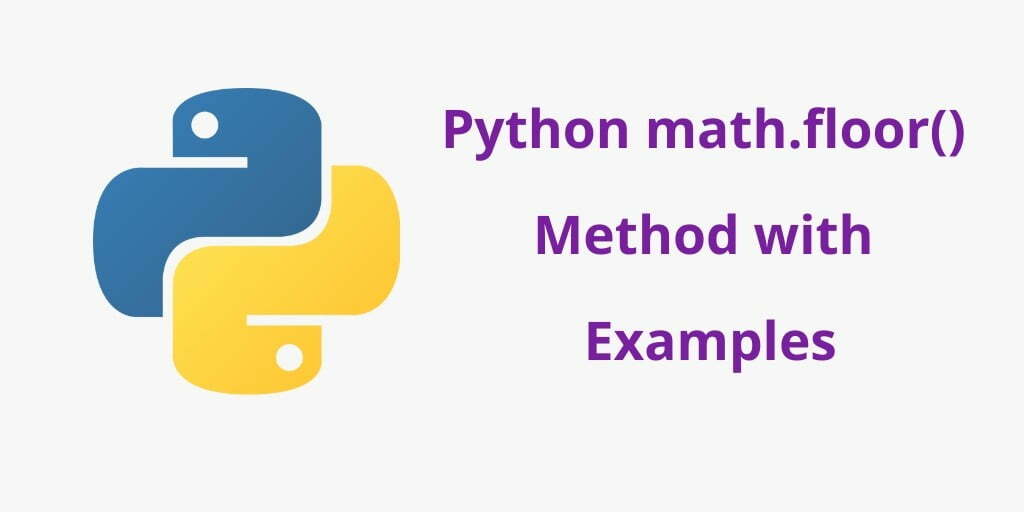Python Math.floor
Python math.floor function is Math Function , which is available in Python math library.
This python math.floor function is used to return the closest integer value which is less than or equal to the specified expression or Value.
Python floor Function Syntax
The basic syntax of the python math floor Function is:
math.FLOOR (Expression)
In this post, we will show you, How to write floor Function in python programming with several examples.
Python Floor Function Example
The floor Function in Python is used to return the closest integer value which is less than or equal to given numeric value.
# Python floor function example import math val = math.floor(12.95) print(val)
OUTPUT
15
In this Python floor example, we are finding the closest value of both positive and negative values.
import math
print('The final result of math.floor(11.45) = ', math.floor(11.45))
print('The final result of math.floor(25.99) = ', math.floor(25.99))
print()
print('The final result of math.floor(-150.49) = ', math.floor(-150.49))
print('The final result of math.floor(-170.99) = ', math.floor(-170.99))
OUTPUT
The final result of math.floor(11.45) = 11 The final result of math.floor(25.99) = 25 The final result of math.floor(-150.49) = -151 The final result of math.floor(-170.99) = -171
Python math.floor Function Example
The following query will show you the multiple ways to use this python floor function.
import math # This allows us to use the floor function
a = 0.54
b = -10.98
c = 90.05
d = 65.98
e = math.floor(2.45 + 7.55 - 14.88)
pi = math.floor(math.pi)
x = [-22.45, 2.40, 9.65] # List Example
y = (-2.45, 22.10, 22.95) # Tuple Example
print(" The Value of 'a' after the floor function is: ", math.floor(a))
print(" The Value of %.2f after the floor function is: %d" %(b, math.floor(b)))
print(" The Value of %.2f after the floor function is: %d" %(c, math.floor(c)))
print(" The Value of %.2f after the floor function is: %d" %(d, math.floor(d)))
print(" The Value of 'e' after the floor function is: ", e)
print(" The Value of 'PI' after the floor function is: ", pi)
print(" ")
printing List values
print(" First Value from List is: ", math.floor(x[0]))
print(" Second Value from List is: ", math.floor(x[1]))
print(" Third Value from List is: ", math.floor(x[2]))
print(" ")
printing Tuple values
print(" First Value from List is: ", math.floor(y[0]))
print(" Second Value from List is: ", math.floor(y[1]))
print(" Third Value from List is: ", math.floor(y[2]))
OUTPUT
The Value of 'a' after the floor function is: 0 The Value of -10.98 after the floor function is: -11 The Value of 90.05 after the floor function is: 90 The Value of 65.98 after the floor function is: 65 The Value of 'e' after the floor function is: -5 The Value of 'PI' after the floor function is: 3 First Value from List is: -23 Second Value from List is: 2 Third Value from List is: 9 First Value from List is: -3 Second Value from List is: 22 Third Value from List is: 22
Difference between int and floor in Python
This is one of the frequently asked question because, both the int and floor functions return the same result for positive values. However, if you check with negative values then you can see the difference.
import math
print('math.floor(100.45) Result = ', math.floor(100.45))
print('math.floor(200.99) Result = ', math.floor(200.99))
print('int(100.45) Result = ', int(100.45))
print('int(200.99) Result = ', int(200.99))
print()
print('math.floor(-150.49) result = ', math.floor(-150.49))
print('math.floor(-260.99) result = ', math.floor(-260.99))
print('int(-150.49) result = ', int(-150.49))
print('int(-260.99) result = ', int(-260.99))
OUTPUT
math.floor(100.45) Result = 100 math.floor(200.99) Result = 200 int(100.45) Result = 100 int(200.99) Result = 200 math.floor(-150.49) result = -151 math.floor(-260.99) result = -261 int(-150.49) result = -150 int(-260.99) result = -260
Python floor Division Example
This operator return the floored result of the division.
# Python floor Division example a = 100 b = 30 x = a / b print(x) y = a // b print(y)
OUTPUT
3.3333333333333335 3
Python floor List Example
Math floor with List and For Loop
Use the math floor function of Python on Python List. In this example, we are using the For Loop to iterate list item and then applying the floor function for each item.
# Python math floor example import math numbers = [-15.99, 25.23, 45.67, -450.11, -650.91] for num in numbers: print(math.floor(num))
OUTPUT
-16 25 45 -451 -651
Math Floor with Map and Lambda function
However, this time we are using the Map and Lambda function to iterate items.
import math
numbers = [-15.99, 25.23, 45.67, -450.11, -650.91]
print(numbers)
print()
floor_result = map(lambda num: math.floor(num), numbers)
print('The final result of math.floor = ', list(floor_result))
OUTPUT
[-15.99, 25.23, 45.67, -450.11, -650.91] The final result of math.floor = [-16, 25, 45, -451, -651]
